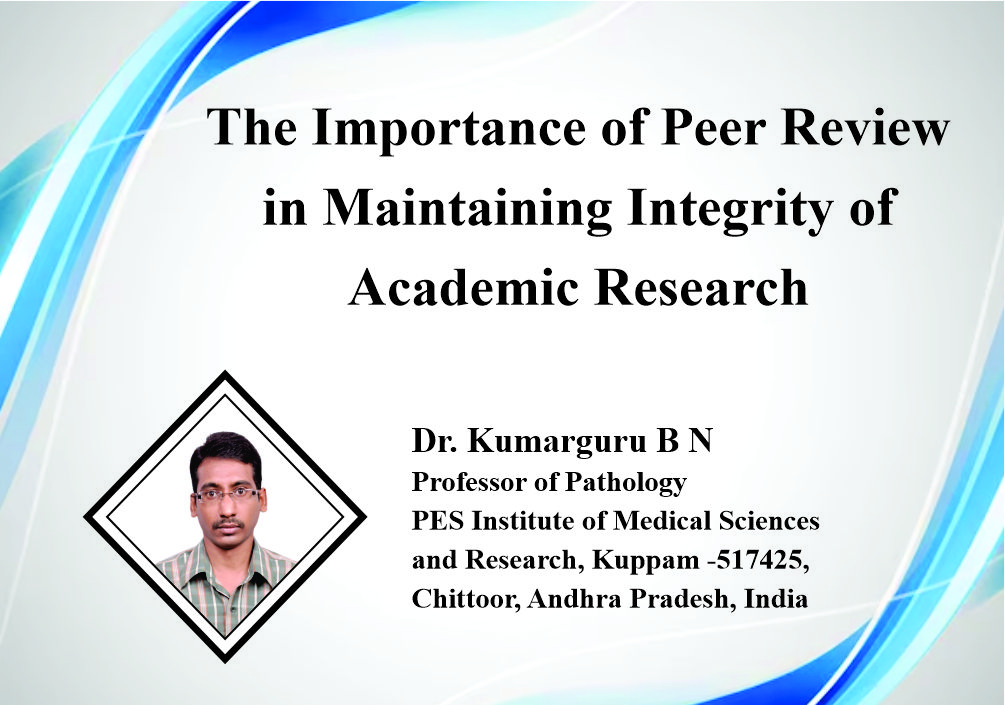What is Peer Review
Peer review is defined as “A Process of subjecting an author’s scholarly work, research or ideas to the scrutiny of others who are experts in the same field”.
It may be considered as craftmanship of a reviewer to scrutinize the research work carefully to improve the quality of the manuscript.
Purpose
The skilful art of reviewing is aimed at helping the author, editor and the publication team to publish a high-quality scientific literature in the journal in order to benefit the scientific community and the mankind.
Common Types
Single-blind peer review: Only review knows the identity of the author and author is blinded to the identity of the reviewer.
Double-blind peer review: Both the reviewer and the author are blinded to each other’s identity.
Open peer review: Both the reviewer and the author know each other’s identity.
Transparent peer review: Only review knows the identity of the author and author is blinded to the identity of the reviewer. But the reviewer’s report is also published in the article.
Post-publication peer review: Review of the article after publication in the journal
Attributes of an Ideal Reviewer
Respond to the invite – To accept the invitation through invitation link in the email only if they can review the manuscript
Be timely – Respond in a timely manner as early as possible
Be professional – Put a sincere effort to help the author and editor
Be pleasant – Not to use harsh word against the authors
Be helpful – Address the shortcoming in the manuscript to improve the quality
Be empathetic – To be sensitive and respectful towards authors
Be scientific – To comment on the scientific content rather than typographical errors (unless the errors compromise the quality of manuscript)
Be realistic – Not to set too high unrealistic bars which cannot be achieved
Be open – To have a broad perspective
Be organized – To be structed and maintain logical flow
Recognition of common errors in scientific literature
Contradicting statements within the same manuscript
Use of incorrect terminology or outdated terminology
Illogical contents lacking commonsense
Findings which are not correlating well with the data
Missing data or incomplete iformation
Circular reasoning
Unwarranted conclusions – not supported by the finding
Implication of Artificial Intelligence in Peer review process
Artificial intelligence may act as double-edged sword – needs to be used with caution
Benefits
Getting recognition for the selfless effort
Helps the authors to improve upon the quality of the manuscript
Helps the editor in decision making – whether to acct or reject the manuscript
Developing good rapport with scientific publishing community
Updating of the reviewer’s knowledge
Limitations
Time consuming process
Mentioning the date of receiving the manuscript may be helpful to overcome the limitation to some extent
Cannot accurately detect plagiarism
The article may be subjected to plagiarism check by the technical team before assigning the article to the reviewer
How to improve the quality of peer review – Bloggers suggestion
Use of Checklist
The review can design their own checklist to evaluate each component of the manuscript for original article (title of the manuscript, abstract, introduction, materials and methods, results, discussion and conclusion) and case reports (title of the manuscript, abstract, introduction, case report, discussion and conclusion)
Example of checklist for introduction (original article)
Is it appropriate to the title
Is the content succinct
Is the train of thought expressed in logical sequence
Does the content need to be rephrased
Is the problem statement addressed
Is the gap in the knowledge expressed clearly
Is the need for the study justified
References
- Kelly J, Sadeghieh T, Adeli K. Peer review in scientific publications: benefits, critiques and a survival guide. The Journal of the International Federation of Clinical Chemistry and Laboratory Medicine 2014;25(3)227-43.
- https://libguides.mssm.edu/peerreview/types

